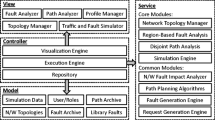Abstract
We address the physical SONET network design problem of selecting stackable, unidirectional rings connecting central office nodes (COs) and remote nodes (RNs). This problem frequently arises in designing feeder transport networks to support centralized traffic between the COs and RNs. We formulate a 0–1 programming model for this problem. A simulated annealing-based Lagrangian relaxation procedure to find optimal or near-optimal solutions is then described. Computational results are reported showing that our procedures produce solutions that are on average within 1.1% of optimality. We show that using simulated annealing to augment the pure Lagrangian approach produces superior solutions to the Lagrangian approach.




Similar content being viewed by others
References
G.R. Boyer, A perspective on fiber in the loop systems, IEEE Magazine of Lightwave Communications Systems 1(3) (1990) 6–11.
Broadband Publishing Corporation, The optical report: Guide to next-gen SONET multiplexing, The ATM & Report 7(11) (2001) 5–6.
S. Cosares, I. Saniee and O. Wasem, Network planning with the SONET Toolkit, Bellcore Exchange (1992) 8–13.
M. Laguna, Clustering for the design of SONET rings in interoffice telecommunications, Management Science 40 (1994) 1533–1541.
S. Martello and P. Toth, Knapsack Problems, Algorithms and Computer Implementations, Wiley, Chichester England, 1990.
R.M. Nauss, An efficient algorithm for the 0–1 Knapsack problem, Management Science 23 (1997) 27–31.
J.S. Park, B.H. Lim and Y. Lee, A Lagrangian dual-based branch-and-bound algorithm for the generalized multi-assignment problem, Management Science 44 (1998) 271–282.
H.D. Sherali, J. Cole Smith and Y. Lee, Enhanced model representations for an intra-ring synchronous optical network design problem allowing demand splitting, INFORMS Journal on Computing 12 (2000) 284–298.
J.C. Smith, Algorithms for Distributing Telecommunication Traffic on a Multiple-ring SONET-based Network, Department of Systems and Industrial Engineering, University of Arizona, P.O. Box 210020, Tucson, AZ 85721, 2002.
J. Sosnosky and T. Wu, SONET ring applications for survivable fiber loop network, IEEE Communications Magazine 29(6) (1991) 51–58.
T. Wu, Fiber Network Service Survivability, Artech House, Boston, 1992.
T. Wu, D.J. Kolar and R.H. Cardwell, Survivable network architectures for broadband fiber optic networks: model and performance comparisons, IEEE Journal of Lightwave Technology 6 (1988) 1698–1709.
Author information
Authors and Affiliations
Corresponding author
Appendix
Appendix
We show excerpts from the code for generating all rings such that each ring contains two central offices (COs) and at least one demand node (RN). Also, total demand associated with chosen nodes can be at most 48, and there can be at most 10 nodes of any type. We do this using exhaustive search with a series of nested loops. If Total = “No”, then there is too much demand or too many nodes already, so the subsequent loops can be skipped. This is key to the success of this exhaustive enumeration approach. Even for the large network problems that we solved which have 75 nodes and 110 links, this took less than 1 CPU second and required storing only about 130 rings.

Rights and permissions
About this article
Cite this article
Park, J.S., Lim, B.H. & LeBlanc, L.J. Design of reliable SONET feeder networks. Inf Technol Manage 8, 19–29 (2007). https://doi.org/10.1007/s10799-006-0003-5
Published:
Issue Date:
DOI: https://doi.org/10.1007/s10799-006-0003-5




